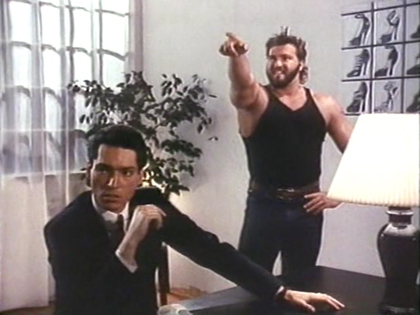technology

How much do you like courgettes? According to one Facebook page devoted to them, hundreds of people find them delightful enough to click the “like” button – even with dozens of other pages about courgettes to choose from.
There’s just one problem: the liking was fake, done by a team of low-paid workers in Dhaka, Bangladesh, whose boss demanded just $15 per thousand “likes” at his “click farm”. […]
That particular Facebook page on courgettes was set up by the programme makers to demonstrate how click farms can give web properties spurious popularity. […]
Sir Billi, a British cartoon film voiced by Sir Sean Connery, has more than 65,000 Facebook likes – more than some Hollywood films.
Although it has so far only been released in South Korea, Facebook data suggests the city of Dhaka is the source of the third-largest number of likes. (The Egyptian capital, Cairo, is presently the source of the highest number.)
{ The Guardian | Continue reading }
buffoons, technology | August 5th, 2013 6:18 am

On average, ATD made less than a penny on every share it traded, but it was trading hundreds of millions of shares a day. Eventually the firm moved out of Hawkes’s garage and into a $36 million modernist campus on the swampy outskirts of Charleston, S.C., some 650 miles from Wall Street.
By 2006 the firm traded between 700 million and 800 million shares a day, accounting for upwards of 9 percent of all stock market volume in the U.S. And it wasn’t alone anymore. A handful of other big electronic trading firms such as Getco, Knight Capital Group, and Citadel were on the scene, having grown out of the trading floors of the mercantile and futures exchanges in Chicago and the stock exchanges in New York. High-frequency trading was becoming more pervasive.
The definition of HFT varies, depending on whom you ask. Essentially, it’s the use of automated strategies to churn through large volumes of orders in fractions of seconds. Some firms can trade in microseconds. (Usually, these shops are trading for themselves rather than clients.) And HFT isn’t just for stocks: Speed traders have made inroads in futures, fixed income, and foreign currencies. Options, not so much. […]
By 2010, HFT accounted for more than 60 percent of all U.S. equity volume and seemed positioned to swallow the rest. […] For the first time since its inception, high-frequency trading, the bogey machine of the markets, is in retreat. According to estimates from Rosenblatt Securities, as much as two-thirds of all stock trades in the U.S. from 2008 to 2011 were executed by high-frequency firms; today it’s about half. In 2009, high-frequency traders moved about 3.25 billion shares a day. In 2012, it was 1.6 billion a day. Speed traders aren’t just trading fewer shares, they’re making less money on each trade.
{ Bloomberg | Continue reading }
related { Today’s Comforting Stat: Hedge funds are a trillion dollars in debt }
technology, traders | August 3rd, 2013 12:49 pm

On a street in Manhattan’s Lower East Side, an unremarkable gray box protrudes from a telephone pole. Inside the box lies a state-of-the-art airflow-sampling device, one part of an experiment to track how a gas disperses through the city’s streets and subway system. […]
The goal of the project is to develop a model for how a dangerous airborne contaminant, such as sarin gas or anthrax, would spread throughout the city in the event of a terrorist attack or accidental release.
The scientists released tiny amounts of a colorless, nontoxic gas at several locations around the city. The airflow samplers, located at various points throughout the city, measured the gas to determine how fast and how far it spread.
{ LiveScience | Continue reading }
unrelated { Eproctophilia is a paraphilia in which people are sexually aroused by flatulence. The following account presents a brief case study of an eproctophile. | Improbable }
crime, olfaction, technology | July 27th, 2013 5:39 am

We’ve all experienced the sense of being familiar with somebody without knowing their name or even having spoken to them. These so-called “familiar strangers” are the people we see everyday on the bus on the way to work, in the sandwich shop at lunchtime or in the local restaurant or supermarket in the evening.
But while many researchers have studied the network of intentional links between individuals—using mobile phone records for example—little work has been on these unintentional links which form a kind of hidden social network.
Today, that changes thanks to the work of Lijun Sun at the Future Cities Laboratory in Singapore and a few pals who have analysed the passive interactions between 3 million residents on Singapore’s bus network (about 55 per cent of the city’s population). […]
Study revealed that about 85 per cent of these repeated encounters happen at the same time of day and that individuals were more likely to encounter familiar strangers in the morning than the afternoon.
{ The Physics arXiv Blog | Continue reading }
photo { Bill Owens }
social networks | July 9th, 2013 4:32 am

Rosa differentiates between mechanical acceleration, the acceleration of social change and the accelerating pace of daily life. The process of mechanical acceleration began in the 19th century in conjunction with industrialization. In terms of the time it takes to travel across the world, for example, it has effectively shrunk the size of the world to one-sixtieth of its actual size.
Today, mechanical acceleration affects the digital sector in particular. But paradoxically, it also goes hand in hand with an acceleration of the pace of life. Even though mechanical acceleration, by shortening the time it takes to complete tasks, was intended to create more available time for the individual, late modern society does not enjoy the luxury of more leisure time, Rosa writes. On the contrary, individuals suffer from a constant time shortage.
The reason for this is our urge “to realize as many options as possible from the infinite palette of possibilities that life presents to us,” he says. Living life to the fullest has become the core objective of our time. At the same time, this hunger for new things can never be satisfied: “No matter how fast we become, the proportion of the experiences we have will continuously shrink in the face of those we missed.” As a result, more and more people suffer from depression and burnout, according to Rosa.
{ Der Spiegel | Continue reading | thanks Rob }
images { 1 | 2 }
ideas, technology | July 7th, 2013 3:16 am
marketing, music, technology | June 30th, 2013 8:18 am
spy & security, technology | June 27th, 2013 5:55 am
photogs, robots & ai | June 26th, 2013 7:22 am

Forget patenting an invention. These days, companies patent conceptual categories for future inventions.
During the first dot-com boom, Amazon famously patented the concept of buying things online with one click. More recently, companies have patented concepts such as scanning documents to an e-mail account, clearing checks electronically and sending e-mail over a wireless network.
The problem with these kinds of abstract patents is that lots of people will independently discover the same basic concept and infringe by accident. Then the original patent holder — who may not have come up with the concept first, or even turned the concept into a usable technology — can sue. That allows for the kind of abusive litigation that has been on the rise in recent years.
A lawsuit over an Internet advertising patent offered a key appeals court an opportunity to rein in these abstract patents. Instead, the court gave such patents its endorsement on Friday, setting the stage for rampant patent litigation to continue unchecked.
A firm called Ultramercial claims to have invented the concept of showing a customer an ad instead of charging for content. The company has sought royalties from a number of Web sites, including Hulu and YouTube. Ultramercial’s patent isn’t limited to any specific software algorithm, server configuration or user interface design. If you build a Web site that follows the general business strategy claimed by the patent, Ultramercial thinks you owe them money.
{ Washington Post | Continue reading }
buffoons, law, technology | June 25th, 2013 11:22 am

Normally, tracking a criminal using DNA requires, at a minimum, that the perpetrator leaves behind a DNA sample in some form or other. As they are not often so accommodating, the role of DNA in crime busting, while significant, has its limits.
Applied DNA Sciences (ADNAS) has developed a new approach to solve crimes using DNA tagging. The difference is that instead of tagging the objects being stolen, they tag the pilferer with DNA. While this has been tried before by applying the DNA to a fleeing criminal with a gun, ADNAS has adopted a more subtle approach. […]
DNA Fog is an airborne suspension of artificial DNA molecules with a known but biologically inert sequence. The DNA molecules (Applied DNA’s SigNature DNA) are artificially constructed, so that a strand of DNA with 20 base pairs can have over a trillion unique combinations. A security system could use one sequence per location, one sequence for each area within the location, or even use RFID tags to instruct a sophisticated spraying device to spray a unique DNA signature for each item stolen.
Once released, DNA molecules attach onto a malefactor’s clothing, shoes, hair, and skin, as well as the objects stolen.
{ Gizmag | Continue reading }
crime, technology | June 18th, 2013 10:29 am

In Jorge Luis Borges short story, Funes el Memorioso, the titular Funes suffers a brain injury that results in an inability to forget. At first his altered status feels more gift than impairment. He is capable of fantastic mental feats. He no longer wastes time trying to learn things by repetition. Every important detail is immediately accessible to his extraordinary brain, allowing him to spend less time on drudgery. He is also able to focus and remember minutiae like he was never capable of before. The world unfolds before him in striking clarity. No data point, however inconsequential, escapes his viselike attention to detail. Alas, this becomes his downfall. He loses focus on the important. Not forced to prioritize on initial intake due to a limited storage capacity, he drowns in a sea of the irrelevant.
In his New York Times piece, “The Web Means the End of Forgetting,” legal commentator Jeffrey Rosen warns of the special problem the web presents, particularly for people’s personal lives. Rosen warns: “we are only beginning to understand the costs of an age in which so much of what we say, and of what others say about us, goes into our permanent — and public — digital files.”
Although new tools like Google’s “Me on the Web” are allowing users to better monitor their personal information available on the web, there is no real means of managing this information. This article seeks to explore what it would take to have enforceable “administrative rights” to one’s personal information – the ability to edit or modify one’s online persona just as a webmaster would be able to edit or modify on an individual website.
{ Jamie R. Lund | PDF }
oil on canvas { Till Rabus }
ideas, social networks, technology | June 17th, 2013 3:00 pm

Holograms of human figures are appearing increasingly often in airports as virtual assistants. And they may also be introduced in various commercial activities. […]
The woman was two-dimensional, a projection on a human-shaped glass sheet. […] She is a product by Tensator®, a “queue control and management solutions” brand. Installed in June of last year, an aviation trade publication reported she cost the airport only 26,000 dollars. The avatar runs 24 hours a day and is portable so she can be moved to other areas of the terminal. […] You will find similar holographic announcers or “airport virtual assistants” in Dubai, Washington Dulles, Macau, Istanbul Ataturk and Long Beach, among other locations. […] The next step will be to install more interactive virtual assistants, which might answer basic questions from travellers about things like flight times, gates or rental car locations. Their plan is to provide models with a touch-screen interface next to the avatar rather than Siri-style speech technology. Voice recognition, while available in the more expensive models (roughly 100,000 dollars) isn’t recommended for airports due to the likelihood of interference from background noise. […]
Musion is better known for their less practical work: reviving dead celebrity singers. Their most famous project was the digital resurrection of Tupac Shakur at last year’s Coachella Festival. The company also recreated Frank Sinatra to perform at Simon Cowell’s 50th birthday party. […] Copyright permissions and objections from various estates, in addition to the high costs, have so far prevented “resurrections” from becoming a more widespread trend.
{ Domus | Continue reading }
art { Wayne White }
robots & ai, technology, weirdos | June 14th, 2013 12:33 pm

{ A new invention aims to foil paparazzi who try to photograph people who do not wish to be photographed. Celebs are equipped with a flashgun that fires automatically the instant another flashgun fires nearby. | Improbable | full story }
celebs, photogs, technology | June 4th, 2013 6:20 am

These new robot-painting machines can wash, apply solvent to remove dirt, rinse and then spray two different paint types. […]
Manually, it takes a team of painters 4.5 hours to do the first coat. The robots do it in 24 minutes with perfect quality. Boeing began using the machine in February. By midsummer, all 777 wings will be painted this way. […]
Half the 777 wing-painting team has been redeployed to other roles, such as programming the machines, painting the airline liveries on the fuselage or working on the sophisticated paint job needed for the 787-9 tails, which have a special smooth aerodynamic finish, Clark said.
{ Seattle Times | Continue reading }
airports and planes, robots & ai | June 4th, 2013 6:20 am

Yahoo didn’t just buy a company, it validated, to the tune of a billion dollars, the notion that bad business is worth pursuing. The entire concept of what makes something a good idea continues to be inverted, warped, and thrown in a gully. This is the idea economy, remember—the industry of fantasy. It doesn’t have to “make sense.” Money isn’t valuable. Success isn’t lucrative. Profit is pointless. These are the industry’s norms. All you need to do to become a billion-dollar business is make people entertained and vaguely interested.
David Karp did just that. Over 100 million entranced humans blog with Tumblr, and not a single one pays for the privilege. They’re free to swap reality show GIFs, aspirational shopping photos, and masturbate, with only the faintest whisper of marketing reaching their ears.
{ Valleywag | Continue reading }
economics, social networks | May 20th, 2013 4:20 pm

Normal vision is essentially a spatial sense that often relies upon touch and movement during and after development, there is often a correlation between how an object looks and how it feels.
Moreover, as a child’s senses develop, there is cross-referencing between the various senses. Indeed, where the links between the senses are not made, there may be developmental problems or delays.
This should be taken into consideration when training new users of visual prosthetics, artificial retinas, or bionic eyes, suggest researchers in Australia.
{ EurekAlert | Continue reading }
photo { Elena Amagro }
eyes, technology | May 2nd, 2013 5:15 am

You probably haven’t heard of HD Moore, but up to a few weeks ago every Internet device in the world, perhaps including some in your own home, was contacted roughly three times a day by a stack of computers that sit overheating his spare room. “I have a lot of cooling equipment to make sure my house doesn’t catch on fire,” says Moore, who leads research at computer security company Rapid7. […]
Moore’s census involved regularly sending simple, automated messages to each one of the 3.7 billion IP addresses assigned to devices connected to the Internet around the world (Google, in contrast, collects information offered publicly by websites). Many of the two terabytes (2,000 gigabytes) worth of replies Moore received from 310 million IPs indicated that they came from devices vulnerable to well-known flaws, or configured in a way that could to let anyone take control of them.
{ Technology Review | Continue reading }
oil on canvas { Miro, Blue III, 1961 }
leisure, technology | April 26th, 2013 1:44 pm

I’d get online and look up and 40 minutes would have gone by, and my reading time for the night would have been pissed away, and all I would have learned was that, you know, a certain celebrity had lived in her car awhile, or that a cat had dialled 911. […] It’s interesting because (1) this tendency does seem to alter brain function and (2) through some demonic cause-and-effect, our technology is exactly situated to exploit the crappier angles of our nature: gossip, self-promotion, snarky curiosity. It’s almost as if totalitarianism thought better of the jackboots and decided to go another way: smoother, more flattering – and impossible to resist.
{ George Saunders/Guardian | Continue reading }
photo { Claudine Doury }
experience, technology | April 26th, 2013 5:39 am

The problem with human-resource managers is that they are human. They have biases; they make mistakes. But with better tools, they can make better hiring decisions, say advocates of “big data”. Software that crunches piles of information can spot things that may not be apparent to the naked eye. […]
Some insights are counter-intuitive. […] For customer-support calls, people with a criminal background actually perform a bit better.
{ Economist | Continue reading }
acrylic and oilstick on canvas { Jean-Michel Basquiat, Light Blue Movers, 1987}
economics, technology | April 24th, 2013 6:09 am





















